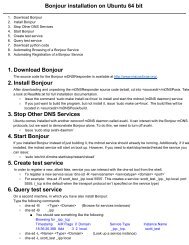<strong>Lab</strong>oratory for Computer Security Education 6# iduid=(500) euid=0(root)Many commands will behave differently if they are executed as Set-UID root processes, instead ofjust as root processes, because they recognize that the real user id is not root. To solve this problem,you can run the following program to turn the real user id to root. This way, you will have a real rootprocess, which is more powerful.void main(){setuid(0);}system("/bin/sh");2.5 Task 2: Protection in /bin/bashNow, we let /bin/sh point back to /bin/bash, and run the same attack developed in the previous task.Can you get a shell? Is the shell the root shell? What has happened? You should describe your observationand explaination in your lab report.$ su rootPassword: (enter root password)# cd /bin# rm sh# ln -s bash sh // link /bin/sh to /bin/bash# exit$./stack// launch the attack by running the vulnerable programThere are ways to get around this protection scheme. You need to modify the shellcode to achievethis. We will give 10 bonus points for this attack. Hint: although /bin/bash has restriction on runningSet-UID programs, it does allow the real root to run shells. Therefore, if you can turn the current Set-UIDprocess into a real root process, before invoking /bin/bash, you can bypass the restriction of bash.The setuid() system call can help you achieve that.2.6 Task 3: Address RandomizationNow, we turn on the Ubuntu’s address randomization. We run the same attack developed in Task 1. Canyou get a shell? If not, what is the problem? How does the address randomization make your attacksdifficult? You should describe your observation and explanation in your lab report. You can use the followinginstructions to turn on the address randomization:$ su rootPassword: (enter root password)# /sbin/sysctl -w kernel.randomize_va_space=2If running the vulnerable code once does not get you the root shell, how about running it for manytimes? You can run ./stack in the following loop , and see what will happen. If your exploit programis designed properly, you should be able to get the root shell after a while. You can modify your exploitprogram to increase the probability of success (i.e., reduce the time that you have to wait).$ sh -c "while [ 1 ]; do ./stack; done;"
<strong>Lab</strong>oratory for Computer Security Education 72.7 Task 4: Stack GuardSo far, we disabled the “Stack Guard” protection mechanism in GCC when compiling the programs. In thistask, you may consider repeating task 1 in the presence of Stack Guard. To do that, you should compile theprogram without the -fno-stack-protector’ option. For this task, you will recompile the vulnerable program,stack.c, to use GCC’s Stack Guard, execute task 1 again, and report your observations. You may report anyerror messages you observe.In the GCC 4.3.3 and newer versions, Stack Guard is enabled by default. Therefore, you have to disableStack Guard using the switch mentioned before. In earlier versions, it was disabled by default. If you use aolder GCC version, you may not have to disable Stack Guard.3 GuidelinesWe can load the shellcode into “badfile”, but it will not be executed because our instruction pointer will notbe pointing to it. One thing we can do is to change the return address to point to the shellcode. But we havetwo problems: (1) we do not know where the return address is stored, and (2) we do not know where theshellcode is stored. To answer these questions, we need to understand the stack layout the execution entersa function. The following figure gives an example.void func (char *str) {char buffer[12];int variable_a;strcpy (buffer, str);}Int main() {char *str = “I am greater than 12 bytes”;func (str);}Current Framestr (a pointer to a string)Return AddressPrevious Frame Pointer (FP)buffer[0] … buffer[11]variable_aHigh AddressCurrent FPLow Address(a) A code example(b) Active Stack Frame in func()Finding the address of the memory that stores the return address. From the figure, we know, if wecan find out the address of buffer[] array, we can calculate where the return address is stored. Sincethe vulnerable program is a Set-UID program, you can make a copy of this program, and run it with yourown privilege; this way you can debug the program (note that you cannot debug a Set-UID program).In the debugger, you can figure out the address of buffer[], and thus calculate the starting point of themalicious code. You can even modify the copied program, and ask the program to directly print out theaddress of buffer[]. The address of buffer[] may be slightly different when you run the Set-UIDcopy, instead of of your copy, but you should be quite close.If the target program is running remotely, and you may not be able to rely on the debugger to find outthe address. However, you can always guess. The following facts make guessing a quite feasible approach:• Stack usually starts at the same address.• Stack is usually not very deep: most programs do not push more than a few hundred or a few thousandbytes into the stack at any one time.




